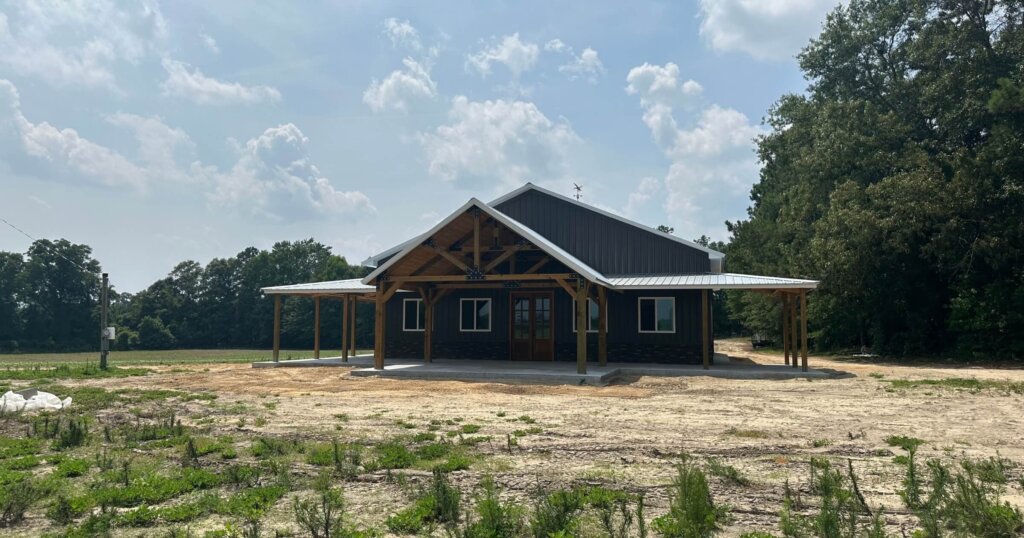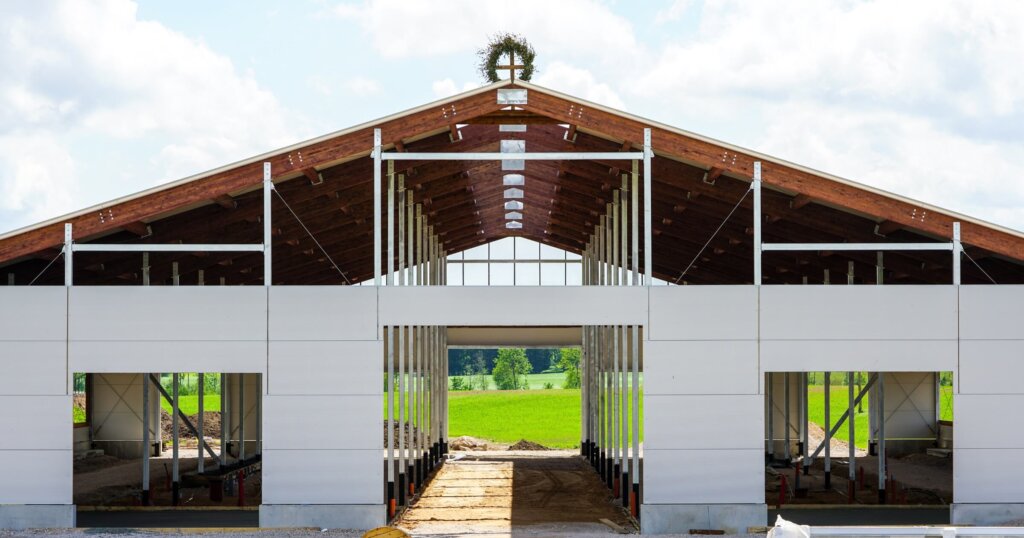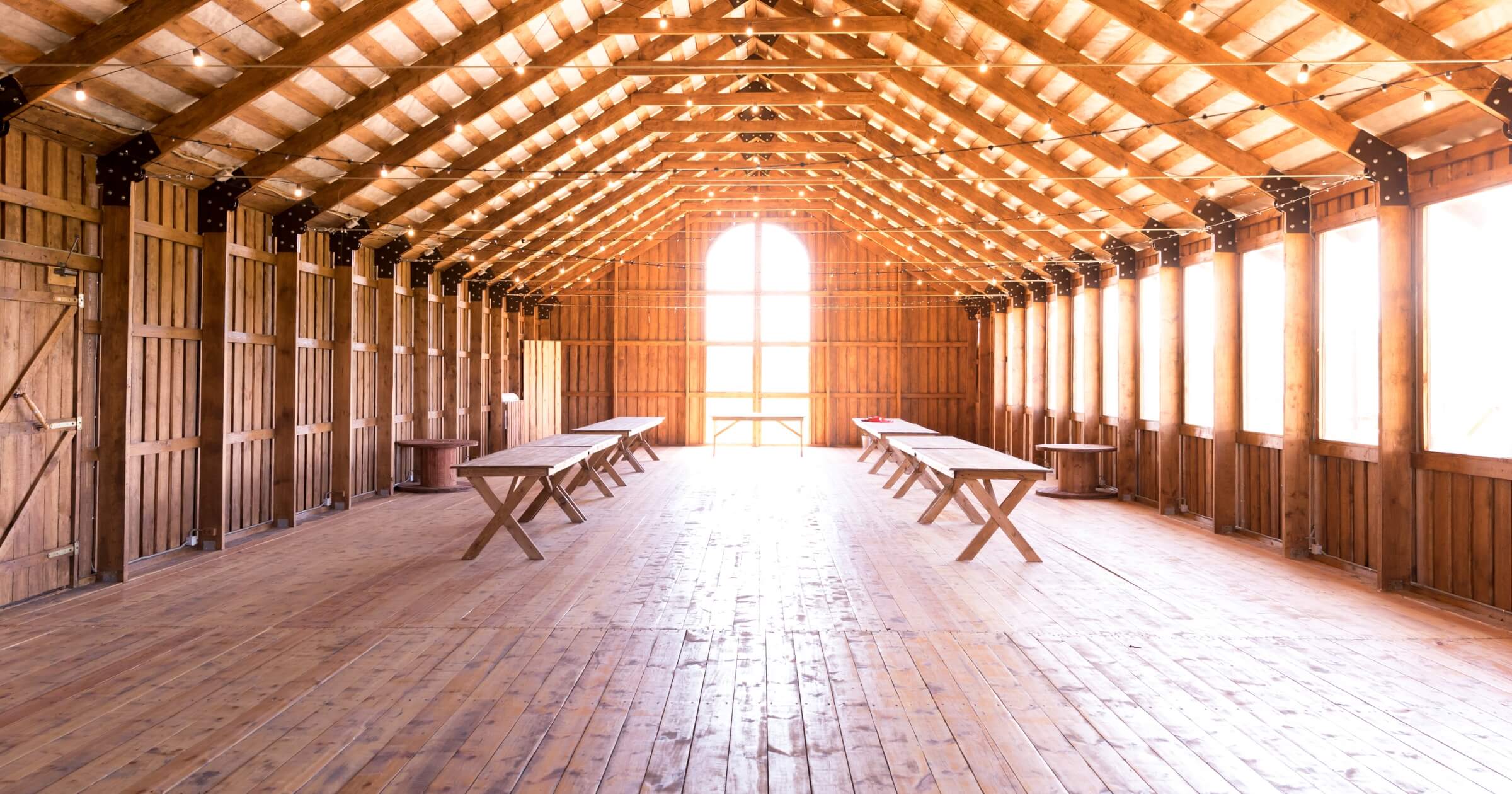Homeowners across North America are turning to barndominiums as a creative, cost-conscious way to get more space without the high price tag of traditional builds. Whether it’s a countryside retreat, a multi-use family home, or a full-time residence with workshop space, these barn-style homes offer flexibility and charm. But before breaking ground, it’s important to get a handle on what it might actually cost. In this guide, we break down how much it costs to build a barndominium, what impacts costs, and the best way to build one.
Quick look:
- Barndominiums typically range from $100K–$300K depending on size, location, and customizations, with per-square-foot costs between $70–$150.
- Barndominium kits provide a cost-effective frame and shell, but you’ll still need to budget for the foundation, utilities, permits, and full interior buildout.
- A 1,200 sq ft barndominium can cost $120K–$160K total, making it a practical choice for downsizers, DIYers, or guest units.
- Pre-built barndominiums offer convenience, but building from scratch gives you more design freedom and potential long-term value.
Average cost to build a barndominium
Most barndominium builds fall somewhere between $100,000 and $300,000, depending on size, location, and how custom you go. For a standard 2,000-square-foot home, you’re likely looking at $150,000 to $250,000 when all is said and done, including land, structure, and interior finishing.
That said, the final number can fluctuate based on a few significant factors. Features like high-end countertops, vaulted ceilings, or oversized garages can quickly drive the price up. On the flip side, DIY labor, basic finishes, or smaller footprints can keep it more affordable.
Where you’re building also plays a huge role. Construction costs in Texas or the Midwest tend to be lower than in California or the Northeast, where both land and labor come at a premium.

Image courtesy of Shutterstock
Cost to build a barndominium per square foot
On average, building a barndominium costs between $70 and $150 per square foot. That range depends heavily on how simple or custom you want to go.
If you’re aiming for a more budget-friendly setup, think basic shell, standard insulation, and no-frills finishes, you might come in closer to $70 per square foot. But if you’re dreaming of quartz counters, hardwood floors, and a custom layout, costs can easily climb to $150 per square foot or higher.
This pricing doesn’t always include land, utilities, or permit fees, just the actual structure and interior buildout, so it’s a good idea to factor those in as you plan your budget.
What impacts the total barndominium cost?
The total price tag for a barndominium isn’t just about square footage; it’s the sum of a lot of moving parts. From the land you build on to the finishes you choose inside, every decision has an impact on your bottom line.
Land prices vary wildly depending on location. A few acres in rural Tennessee might cost less than a city-sized lot in California. Beyond the purchase price, land preparation, such as clearing trees or grading, can add to your total.
Your foundation choice also matters. A slab-on-grade is the most cost-effective option while adding a crawl space or basement means more digging, materials, and labor.
When it comes to the frame, most barndominiums use steel for durability and ease of construction, but some still opt for wood, which can influence both price and fire resilience. If you’re building in wildfire-prone areas, it’s worth exploring how to design for fire resilience right from the ground up.

Image courtesy of Shutterstock
Don’t forget about utilities. If you’re off the beaten path, running septic systems, electrical, and water lines can get pricey. In some cases, it may cost as much as the structure itself, especially if you’re far from municipal hookups.
Labor is another major variable. Going the DIY route or acting as your own general contractor can save money, but it takes time and know-how. Hiring pros will speed things up but also add to your cost.
Finally, the interior finishes, such as flooring, cabinetry, appliances, and lighting, can dramatically impact your overall spend. One way to control those costs is by exploring simpler construction methods, such as panelized building systems, which reduce waste and labor time.
Building a barndominium is all about balance: where you’re building, how you’re building, and what you want your space to feel like once it’s done.
What are barndominium kits, and how much do they cost?
Barndominium kits are a popular option for folks who want to simplify the building process and save some money upfront. A typical kit includes the structural steel frame, roof panels, exterior walls, and sometimes windows and doors.
What it doesn’t include is the interior work: no plumbing, wiring, drywall, flooring, or kitchen cabinets. It also won’t cover labor, permits, or site prep, so you’ll need to budget for those separately.
As for pricing, barndominium kits vary based on size and design:
- 1,200 sq ft kit: around $30,000–$50,000
- 2,000 sq ft kit: closer to $50,000–$75,000
One of the biggest benefits of going the kit route is speed; these structures are often faster to erect, especially for experienced DIYers or small crews. Kits also offer predictability in terms of cost and materials, which can be a relief during times of supply chain issues.
That said, they’re not a turnkey solution. You’ll still need to handle the interior buildout, land preparation, foundation work, and permits, so it’s important to go in with a clear picture of the full scope.
Small barndominium cost breakdown
If you’re trying to keep costs down or just want a modest, functional space, a smaller barndominium (around 1,200 square feet) can be a great option. Here’s a rough breakdown of what you might expect to spend:
- Land: $20,000–$50,000 depending on location, accessibility, and whether utilities are already in place
- Barndominium kit: Around $35,000 for the exterior shell and frame
- Finishing: $60,000–$80,000 to cover the foundation, plumbing, electrical, insulation, drywall, flooring, cabinetry, appliances, and permits
That puts your total cost somewhere between $120,000 and $160,000, which is significantly more affordable than many traditional builds.
For first-time home builders or those looking to downsize or add a guesthouse or rental unit, this kind of small-scale “barndo” is a smart, flexible investment, especially if you’re comfortable doing some of the work yourself.
Is it cheaper to build or buy a barndominium?
Buying a pre-built barndominium might seem like the easier and more affordable option, at least initially. It offers the convenience of a quicker move-in timeline and fewer decisions to make along the way. But there’s a tradeoff: you’ll have less control over the layout, design, and finishes, which may mean compromising on your vision.
On the flip side, building your own barndominium gives you the freedom to customize everything from the floor plan to the fixtures. While it typically comes with higher upfront costs and more legwork (like managing permits, hiring contractors, or coordinating a kit install), it can offer better long-term value, especially if you build smart and stick to a well-planned budget.
Which option is cheaper depends on a few factors:
- Land prices in your area
- Local permit and inspection requirements
- How much time and effort you’re able (or willing) to invest
- Whether you’re hiring pros or taking the DIY route
Ultimately, it comes down to what matters most: speed and simplicity or control and customization.
Bottom line
Building a barndominium can be a cost-effective and rewarding way to create a home that fits your style and needs, but only if you have a solid plan. Prices can vary widely depending on the size of the build, materials, finishes, location, and how much work you’re handling yourself.
Before moving forward, get multiple quotes, talk to local builders, and run the numbers on everything from land prep to interior finishes. And most importantly, consider whether a barndominium is a good fit for your lifestyle, long-term goals, and budget.
For more practical building tips, gear roundups, and design inspiration, subscribe to our newsletter for fresh ideas every week, straight from the jobsite.


